19 Beans and Legumes High in Fiber
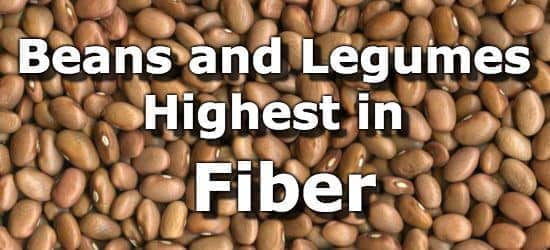
Beans are a great source of fiber, with the average cup of beans providing over 50% of the daily value (%DV). Eating more fiber significantly decreases the risk of heart disease, colon cancer, and other serious medical conditions. (1)
Beans high in fiber include navy beans, small white beans, adzuki beans, split peas, lentils, pintos, mung, chickpeas, and kidney beans. The current daily value (DV) for fiber is 28 grams. (2)
Below is a list of 19 beans high in fiber. For more, see the nutrient ranking of over 50 beans high in fiber.
List of Beans High in Fiber
-
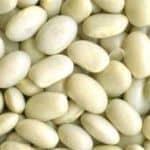 1. Navy (Haricot) Beans + Add
1. Navy (Haricot) Beans + Add
Fiber
per CupFiber
per 100gFiber
per 200 Calories19g
(68% DV)11g
(38% DV)15g
(54% DV) -
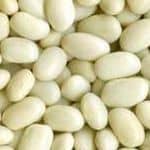 2. Small White Beans + Add
2. Small White Beans + Add
Fiber
per CupFiber
per 100gFiber
per 200 Calories19g
(66% DV)10g
(37% DV)15g
(52% DV) -
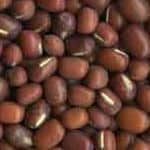 3. Adzuki Beans + Add
3. Adzuki Beans + Add
Fiber
per CupFiber
per 100gFiber
per 200 Calories17g
(60% DV)7g
(26% DV)11g
(41% DV) -
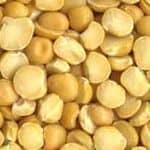 4. Split Peas + Add
4. Split Peas + Add
Fiber
per CupFiber
per 100gFiber
per 200 Calories16g
(58% DV)8g
(30% DV)14g
(50% DV) -
 5. Lentils + Add
5. Lentils + Add
Fiber
per CupFiber
per 100gFiber
per 200 Calories16g
(56% DV)8g
(28% DV)14g
(49% DV) -
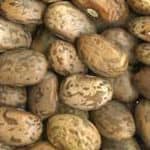 6. Pinto Beans + Add
6. Pinto Beans + Add
Fiber
per CupFiber
per 100gFiber
per 200 Calories15g
(55% DV)9g
(32% DV)13g
(45% DV) -
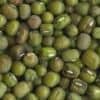 7. Mung Beans + Add
7. Mung Beans + Add
Fiber
per CupFiber
per 100gFiber
per 200 Calories15g
(55% DV)8g
(27% DV)14g
(52% DV) -
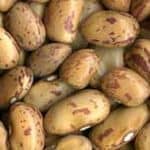 8. Cranberry (Borlotti) Beans + Add
8. Cranberry (Borlotti) Beans + Add
Fiber
per CupFiber
per 100gFiber
per 200 Calories15g
(54% DV)9g
(31% DV)13g
(45% DV) -
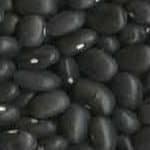 9. Black Beans (Frijoles Negros) + Add
9. Black Beans (Frijoles Negros) + Add
Fiber
per CupFiber
per 100gFiber
per 200 Calories15g
(53% DV)9g
(31% DV)13g
(47% DV) -
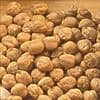 10. Chickpeas (Garbanzo Beans) + Add
10. Chickpeas (Garbanzo Beans) + Add
Fiber
per CupFiber
per 100gFiber
per 200 Calories12g
(45% DV)8g
(27% DV)9g
(33% DV) -
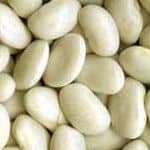 11. Great Northern Beans + Add
11. Great Northern Beans + Add
Fiber
per CupFiber
per 100gFiber
per 200 Calories12g
(44% DV)7g
(25% DV)12g
(42% DV) -
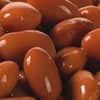 12. Kidney Beans + Add
12. Kidney Beans + Add
Fiber
per CupFiber
per 100gFiber
per 200 Calories11g
(40% DV)6g
(23% DV)10g
(36% DV) -
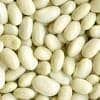 13. Large White Beans + Add
13. Large White Beans + Add
Fiber
per CupFiber
per 100gFiber
per 200 Calories11g
(40% DV)6g
(23% DV)9g
(32% DV) -
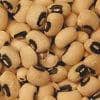 14. Black-Eyed Peas (Cowpeas) + Add
14. Black-Eyed Peas (Cowpeas) + Add
Fiber
per CupFiber
per 100gFiber
per 200 Calories11g
(40% DV)7g
(23% DV)11g
(40% DV) -
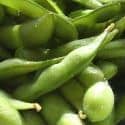 15. Boiled Soybeans (Edamame) + Add
15. Boiled Soybeans (Edamame) + Add
Fiber
per CupFiber
per 100gFiber
per 200 Calories10g
(37% DV)6g
(21% DV)7g
(25% DV) -
 16. Natto (Fermented Soybeans) + Add
16. Natto (Fermented Soybeans) + Add
Fiber
per CupFiber
per 100gFiber
per 200 Calories9g
(34% DV)5g
(19% DV)5g
(18% DV) -
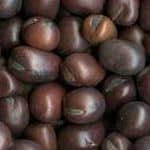 17. Broad Beans (Fava) + Add
17. Broad Beans (Fava) + Add
Fiber
per CupFiber
per 100gFiber
per 200 Calories9g
(33% DV)5g
(19% DV)10g
(35% DV) -
 18. Firm Tofu + Add
18. Firm Tofu + Add
Fiber
per CupFiber
per 100gFiber
per 200 Calories6g
(21% DV)2g
(8% DV)3g
(11% DV) -
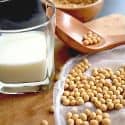 19. Unsweetened Soymilk + Add
19. Unsweetened Soymilk + Add
Fiber
per 16oz GlassFiber
per 100gFiber
per 200 Calories2g
(7% DV)0g
(1% DV)2g
(9% DV)
How much fiber do you need each day?
The daily value (DV) for fiber is 28 grams per day. (2) This is the amount shown on food labels to help the average person compare the health benefits of different foods. However, for many people, this amount is actually too low.
The adequate intake (AI) is a more accurate daily target, and varies by age and gender. The AI for fiber is up to 38 grams per day. (3) We've included the specific values below for various groups below, so you can determine what your personal target should be.
The average American consumes far less than the DV for fiber, let alone the AI for their demographic group. (4)
Here is the breakout of the adequate intake by age and gender for fiber: (3)
| Life Stage | RDA |
|---|---|
| Children | |
| 1-3 years old | 19g |
| 4-8 years old | 25g |
| Males | |
| 9-13 years old | 31g |
| 14-50 years old | 38g |
| 50+ years old | 30g |
| Females | |
| 9-18 years old | 26g |
| 19-50 years old | 25g |
| 50+ years old | 21g |
| Pregnancy | |
| 14-50 years old | 29g |
| Lactation | |
| 14-50 years old | 29g |
From the Nutrient Ranking Tool
Use the ranking tool links below to select foods and create your own food list to share or print.
- Foods High in Fiber
- Foods Low in Fiber
- Vegetables High in Fiber
- Fruits High in Fiber
- Vegetarian Foods High in Fiber
- Nuts High in Fiber
- Grains High in Fiber
- Beans High in Fiber
- Breakfast Cereals High in Fiber
- Fast Foods High in Fiber
View more nutrients with the nutrient ranking tool, or see ratios with the nutrient ratio tool.
Related
Data Sources and References
- Thomas M. Barber, Stefan Kabisch, Andreas F. H. Pfeiffer and Martin O. Weickert The Health Benefits of Dietary Fibre Nutrients. 2020 Oct; 12(10): 3209.
- FDA on Daily Values
- Institute of Medicine Dietary Reference Intakes
- Diane Quagliani, MBA, RDN, LDN and Patricia Felt-Gunderson, MS, RDN, LDN Closing America’s Fiber Intake Gap Am J Lifestyle Med. 2017 Jan-Feb; 11(1): 80–85. Published online 2016 Jul 7. doi: 10.1177/1559827615588079
- U.S. Agricultural Research Service Food Data Central
Simplify Nutrition Tracking with MyFoodData!
Speedy Tools and Detailed Data FREEEasily analyze your meals to find the best foods for your goals.
✅ Use our recipe nutrition calculator and nutrition comparison tool.
✅ Access expert nutrition data tools and in-depth articles.
✅ Log foods and organize your recipes with a free account.


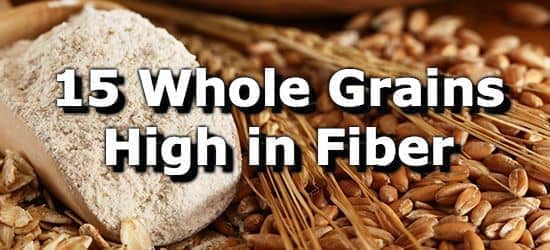 Next ➞
Next ➞
